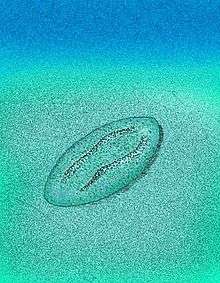Vendoglossa tuberculata
| Vendoglossa tuberculata Temporal range: Precambrian | |
|---|---|
 | |
| artist's reconstruction | |
| Scientific classification | |
| Kingdom: | Animalia |
| Phylum: | incertae sedis |
| Genus: | Vendoglossa |
| Species: | V. tuberculata |
| Binomial name | |
| Vendoglossa tuberculata | |
Vendoglossa tuberculata is a fossil from the Nama Group of Namibia from the Precambrian period. It is also known as the "cat's tongue organism".[1]
The fossil has been interpreted as a dorso-ventrally compressed stem-group metazoan, with a large gut cavity and a transversely ridged ectoderm. It has the shape of a flattened torus, with the long axis running through the approximate center of the presumed gut cavity.[2] V. tuberculata is similar to other Pteridinium fossils in the way in which it has been preserved. It differs significantly in being crossed by rows of tiny papillae, as with a cat's tongue, rather than having the quilted pattern that is common with other Ediacara biotas.[1]
See also
References
Citations
- 1 2 Rich & Komarower 2007, p. 395.
- ↑ McMenamin 2009.
Sources
- McMenamin, M. A. S. (2009). Paleotorus: The Laws of Morphogenetic Evolution. Meanma Press. ISBN 978-1-893882-18-8.
- Rich, Pat Vickers; Komarower, Patricia (2007). SP286 - Rise & Fall of Ediacaran Biota. Geological Society. p. 395. ISBN 978-1-86239-233-5. Retrieved 13 December 2012.
This article is issued from Wikipedia - version of the 10/20/2016. The text is available under the Creative Commons Attribution/Share Alike but additional terms may apply for the media files.